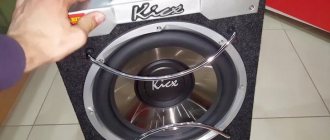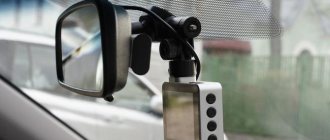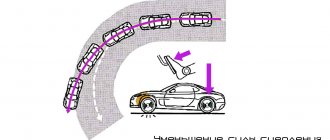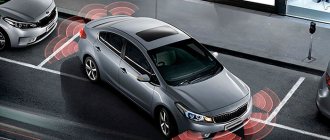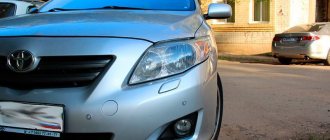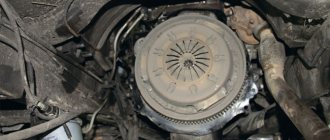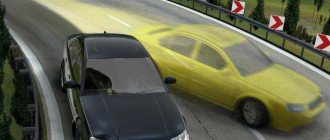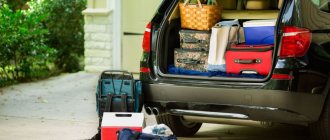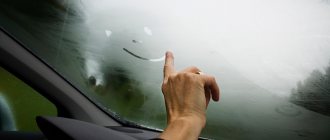Installing a rear view from the cabin
The interior mirror estimates the distance to vehicles behind more accurately. This is due to the fact that its surface is flat, although there are models with an increased viewing angle.
Setting up rear view in the cabin
It is easier to adjust the inside mirror than the side mirrors. It should cover as much of the rear windshield as possible, starting from the very bottom. If, when sitting high, the reflection slightly catches the driver's headrest or part of your face, this is quite acceptable. In a normal body position, the driver should not see the ceiling of the cabin or the trunk of the car.
It is worth saying that it is undesirable to hang various toys on the interior mirror. They can block some object in front of the car, or the glare of the sun can be reflected from the glossy surface into the driver's eyes.
Blind Spots
Blind spots are those areas near the car that the driver cannot see when looking in the rearview mirrors. To reduce them to a minimum, you need to understand how to properly adjust the mirrors in a car for the driver, because blind spots pose a serious danger and the risk of an accident.
The most common situation is when a car is overtaking and enters the blind spot. The driver, looking in the left mirror, does not see the moving car and also makes a maneuver (turning left or overtaking), resulting in a collision.
Consequently, if you do not notice the moment a car enters a blind spot, there is a risk of damaging the car or harming yourself and its passengers. That's why every driver should know how to properly adjust the mirrors in a left-hand drive car and minimize blind spots.
By the way, today there are cars with special electronic devices that monitor these zones and notify the driver that any vehicle is in this zone. Unfortunately, only a few cars have such a system.
Setting up mirrors
The side rearview mirror is more important for the driver. In some vehicles, the interior does not play a role at all when maneuvering.
Most side mirrors have a slightly convex surface, which increases visibility and reduces the blind spot. The common requirement for both mirrors is that the driver should see a small section of the rear wing of the car in it, and in the lower part there should be a reflection of the road surface.
Left rear view mirror
This is the mirror most used by the driver and the safety of the trip largely depends on the correct adjustment of it. In it you must definitely see the horizon line: more than half of the reflection should be occupied by the earth, and approximately 35 - 40% by the sky. There must be a reflection of the side of the car in the lower right corner.
Setting from the driver's side
In some modern cars, the left rear view mirror has virtually no “blind spot” due to the division of the reflective surface. At the bottom, the view is wider, which minimizes the “dead zone”.
Right rear view mirror
By and large, the setting is the same as for the left one, but for maximum efficiency, the driver must see more of the road surface in the right mirror than in the left one. Approximately 70% earth, and 30% sky.
Right side setting
Some inexperienced drivers deliberately lower the right mirror as low as possible. This makes it easier to see curbs and other obstacles when parking. On some modern cars it automatically lowers when driving in reverse.
In order to check that the settings are correct, it is better to ask a friend to help do this. While you are in the car, another person walks past the back of the car at a distance of about two meters. It should be visible first in one side mirror, then in the interior mirror, and finally in the other side mirror. If the blind spots are very large, the angle of the side mirrors should be adjusted until the blind spot is reduced to a minimum.
Watch the video for self-setup:
How to properly adjust car mirrors
To adjust the mirrors in your car correctly, you need to take into account a number of features:
- the driver must take the correct position and adjust the driver's seat;
- adjust the steering column by reach and height (if possible);
- adjust the side mirrors and rear view mirror;
Please note that only after completing the seat and steering wheel adjustments can you move on to the question of how to properly adjust the mirrors. Let us note right away that adjusting the mirrors in a car comes down to getting the best (all-round) view around the car. In this case, the adjustment of the side mirrors (external) and rear view mirror (interior) must be performed simultaneously.
Adjusting the side mirrors
To understand how to properly adjust external side mirrors, you need to divide such mirrors into a left (driver's) and a right mirror. The left side mirror should be adjusted as follows:
- the driver takes a comfortable position in the pre-adjusted driver's seat,
- next you need to turn your head a little to the left and look out the window, adjusting the position of the mirror so that you see only a small part of the rear wing of your car and maximum space behind the car;
To adjust the right outside mirror:
- the head needs to be turned towards the center of the car;
- then, by making adjustments, you need to ensure that you can see the right wing in the right mirror;
- When viewed from the driver's seat, instead of the entire wing, only its edge will be visible.
Please note that if from the driver's seat in the right side mirror most of the rear wing of the car is visible, and not its edge, then the mirror is not adjusted correctly. It is important to immediately get used to the fact that in correctly configured side mirrors (both left and right) there is practically no reflection of your car.
How to adjust the rear view mirror in the cabin
The interior mirror is designed to view the road from behind the car and from the side. To understand how to adjust the interior mirror correctly, you should focus on the central point of visibility of the rear window. The center of the mirror should coincide with the center of the rear window.
To adjust the rear view mirror:
- the driver must take the correct position in the seat;
- then you need to adjust the mirror so that through it you can fully see the rear window of the car, and also be able to partially view the side sections of the road.
Assistive devices
In order to reduce or completely eliminate the blind spot, you can install an additional rear view mirror with an expanded view.
Additional rear view mirror
A mirror extension can also help. The design, on the one hand, looks ridiculous, but sometimes it is really useful. The extension can be placed before a complex reverse maneuver, and then removed.
Extension for mirror
On sale you can find an interior rear view mirror with a monitor, to which an image is transmitted from a camera installed on the rear bumper of the car. It is very useful to have rear parking sensors, which will notify you with an audible signal of any obstacles behind the car.
When should you use rear view mirrors?
Not only beginners who got behind the wheel of a car for the first time, but also experienced drivers are sometimes interested in when to use the car’s rear-view mirrors.
It is necessary to use rear view mirrors:
- When starting off. When pulling away from the curb, you need to make sure that there is no moving vehicle behind you. According to traffic rules, a parked car that begins to move must allow all moving cars to pass.
- When overtaking or other maneuver. If you need to overtake, then first of all you need to make sure that someone else is not already overtaking you. With poorly adjusted mirrors, it will not be possible to reliably determine whether someone is overtaking or not.
- When changing lanes.
- When braking or stopping the car.
- Before opening the driver or passenger side door.
- When moving backwards, including when parking the vehicle.
Why is a mirror your safety?
One day, leaving a car wash, I suddenly felt discomfort, which grew with every meter of the journey. It’s strange, nothing seems to have happened, the car is moving, and I’m like a blind person... The reason was discovered quite quickly: the interior mirror disappeared, which is why I was almost “blind.” It was lying near the pedal assembly, almost blocking my brake and gas.
I returned to the car wash, but they pretended that they were seeing me for the first time. In fact, the following happened: the washer, who was cleaning the interior, unwittingly “swept away” the mirror glued to the windshield. Frightened, I hid it under the pedals, not even thinking that this could end in a serious accident for me.
Everything worked out fine, but I will remember driving without a interior mirror for the rest of my life. It is important to note that I had a VAZ V8 with a huge rear window. Thanks to this, the view from the cabin was such that exterior mirrors were almost not required. They, of course, helped me get to the service center, where the mirror was put in place, but the usual scale of the picture behind my back was clearly not enough.
Here's another case: I bought a panoramic rear-view mirror and attached it to the standard one. I drove off, but the distortion was such that I stopped feeling the distance between me and the cars behind me. The discomfort was terrible, and I returned the mirror to the store.
What is all this for? Moreover, even these short moments without a normal view could lead to an accident. And you wouldn’t prove to anyone that someone let you down. This means that we take mirrors very seriously and do not touch them until we are sure that they are configured correctly.
Listen to the recommendations
After the driver has managed to correctly adjust the mirrors in the car, the driving will be unusual. But after a few days you will get the hang of it and will be surprised that you drove differently before.
Care and caution should be exercised when parallel parking. Be sure to keep an eye on the side of your own car, as well as the one next to you.
Check your car mirrors regularly. But not only when you need to change lanes or perform a maneuver. Be aware of the situation on the track. This will help you correctly perform unexpected or sudden movements.
When maneuvering, a quick glance over your shoulder will help you orient yourself, cast to obtain more complete information about the actions of participants in the traffic flow.
Even with the most careful adjustments, mistakes can be made. To check the effectiveness of the setting, ask a passenger or another person to walk around your car at a distance of about 2 meters. The driver sits behind the wheel, watching the assistant’s movements - he should not disappear from the field of view.
